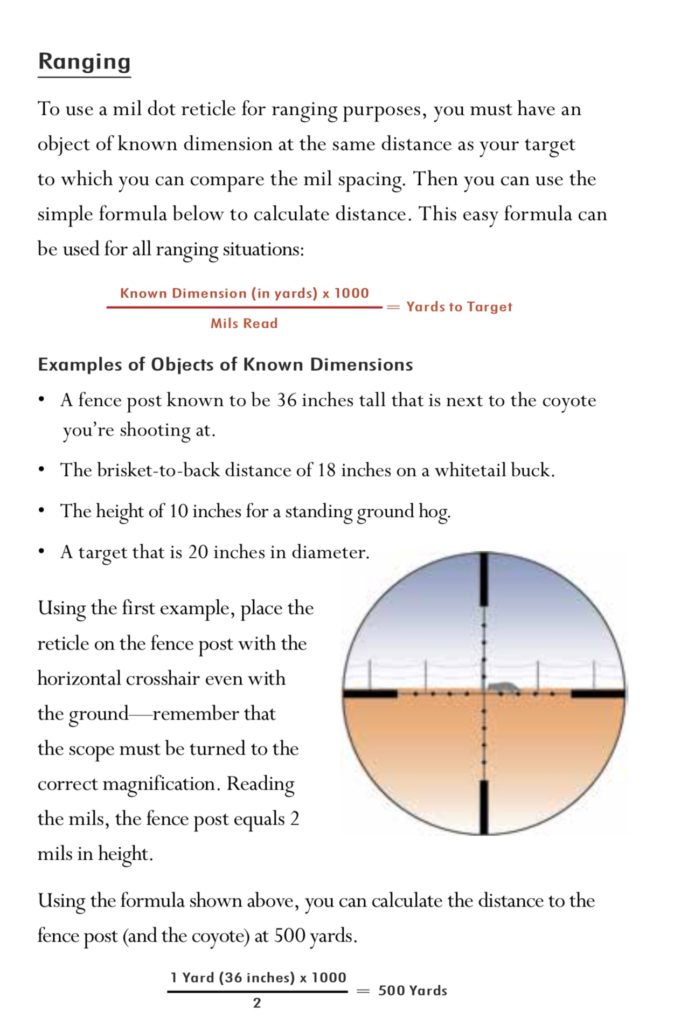
Nothing causes fits of frothing at the nostrils in older folks than the discussions that challenge long held ideas which are surpassed by better things. One such challenge involves which angle of measure you choose to employ in your long range shooting. I am not discussing “I held on ‘is back and I got ‘im….but had to track ‘im a few hunert yards” style of Kentucky windage shooting here. I am also not discussing inches or simple crosshair reticle scopes.
I am pretty adamant that most engagements will be close during an event, probably most will be under 50 feet! Yep, your carbine or pistol (or AR pistol) will be the tool that you depend on most and carbines can be used out to 700 yards or so with the correct ammunition but….Because we like to be prepared, the ability to shoot longer ranges accurately and with enough power to disable mechanical things and organic things means we need a tool with more capability at our disposal than our AR or AK.
The .308W has been around a long time as has it’s daddy the 30-06. Heck about anything from 7mm-08 to 338LM is in the zone we’re discussing but the new kid on the block is the 6.5 Creedmoor and for good reason. Very high BC (aerodynamic properties) means it stays supersonic long past where the .308 is sucking wind. It fits easily into SR25/AR10 platforms (remember, semi-auto is a force multiplier). Half the recoil of .308 and much much better wind bucking make it a standout. If you have hundreds of rounds of match .308 ammo already, stick with what you have but if you’re buying new gear and ammo, the ammo costs for match quality and hunting ammo are similar and actually favor the Creedmoor. If you’re in the market for a great cartridge for the use we’re talking about here, give the CM a hard look.
Both MOA (minutes of angle) and Milliradians are units of ANGLE, not linear in any form or fashion but slices of a circle. Folks who think MOA is an inch at a hunnert’ are close, but are not fully understanding the subject.

It is true that at certain distances both of these units of measure correlate to a linear distance from point of aim to point of impact but this is not the way to think of or understand how to use the systems. While BDC style reticles are popular and if they line up with your cartridge of choice, they are fine for shorter distances and minute of man, for those who want to put a 147g ELD into a hat at 800 yards, read on.
Mils. Sounds all military doesn’t it? It is actually a unit of angle, which is simply 1/1000th of the radius. Being based on 10 it is very easy and quick to use, once you understand what it is, and what it does. To communicate with the majority of long distance shooters these days, speaking “mil” makes sense. With a mil hash reticle what we have in practical shooting is a ruler in front of your eyes. We will get to ranging in a moment, but basically you fire and if using correct technique you spot your impact, quickly measure in your reticle your correction on the vertical and horizontal axis, correct, fire and hit.
A mil is a mil at 10 yards or a mile, what you see in your reticle is the same whatever the distance. See it in the ruler in front of your eyes and correct that amount to make a hit. Now some scopes are second focal plane and the reticle is accurate only at full power for ranging, which is why I prefer first focal plane scopes. A FFP scope is one where the reticle grows and shrinks as power changes so the reticle is true regardless of power setting. While more and more obscure, there are MOA reticles and the same things are true about them, a MOA is a unit of angle and if you were using a MOA hash reticle you still use it the same way. Ranging is where that unit falls short.
To range with a reticle is really a skill that is increasingly being replaced with electronics but it is a legacy skill that needs to be understood. It is easy with a mil based scope. The formula is simply *Known Dimension (in yards, inches, feet, centimeters x 1000) / mils read= Yards/inches/feet/centimeters to Target*. A mil is simply an angle where the wide end on the “pie” is equal to 1/1000th of the radius. So a mil is a yard at 1000 yards, a meter at 1000 meters, a foot at 1000 feet…it isn’t metric as some propose, it works with anything from mm to yards to miles. It is based on 10 which makes the math easy.


If I still have your attention and you didn’t go back to watching fails of the week videos…here is a great article for those who are still not quite getting it and are worried that switching now is going to be too hard. It’s not harder, it’s easier. If you want to shoot and get proficient at long range ACCURATE shooting and interact with the folks who can help you, be it range rats to professional trainers you need to speak “mil”.
Here is Frank from Sniper’s Hide, a well known and accomplished long range shooter on the subject.
Below is a tool no serious long range shooter using a mil based reticle should be without. It is a slide rule for all things mil, and allows fast ranging and correction with zero math, even though the math is easy.
http://swfa-ss.com/index.php/accessories/ballistic-cards/mil-dot-master
Another thing to download and buy for under $15 is a ballistic program. Some are free, but as we all know if something is free then you are the product being sold. I prefer and use StrelokPro and it has proven to be very precise. It allows multiple rifles from your 22 to your cannon and different cartridges under each one. It has a cartridge database with hundreds of known factory ammo info, so choosing the right load for your data is easy. Even 22LR is well represented with tons of loads from most manufacturers. I have it on my phone and tablet and a full discussion will be coming but trust me, you need this to get into this discipline.
I know some guy out there is gonna say “I been shootin’ 25 years using MOA based scopes and all my dope is in MOA so how do I figure out what to use for 200 to 1000 yards”, which is a good question. If you have numbers for your rifle and your previous scope was adjusted in MOA we have a conversion you can use to keep your same dope only converted to Mils.
To convert your current MOA values to Mils divide the MOA by 3.438 and that will give you the Mils to use. For example if you use 8 MOA at 400 yards you would use 2.3 Mils at the same distance. Do this before you hit the range then simply read your range card in the same fashion as before, only now instead of needing to remember your dope from 0 to roughly 38MOA you can now do it only needing to count to 12 Mils. Most scopes are adjusted in 1/10th of a mil.
Look, we’re not talking 5.56 carbines with RDS or 1-4x scopes here for 250 yard shots.
Out to 250, put on chest and squeeze if you have a 50/200 zero. We’re talking about shots at much farther on much smaller targets. Ranging as well…looking at a man at 700 yards vs. 800 yards with the naked eye won’t be different enough to be able to range correctly by guessing. Making that mistake with a 308 would be a difference of possibly 5 feet! The mil reticle can range it though.
Man looks about 6’ tall (2 yards) he measures about 1.5 mils in my reticle, formula is known dimension x 1000 / mils read in reticle so….. 2×1000=2000/1.5=1333 yards….better not try it with my .22LR LOL
So I whip out my new 6.5 Creedmoor SR25 (which I will do a post on soon) and dial 13.5 mils and pop a hole all the way through his chest….now it isn’t quite that simple, wind is a huge factor and we’ll discuss it soon. But the vertical part is JUST THAT SIMPLE.
A 5mph crosswind can push your projectile off course at 1000 yards by 30” with a 6.5C (147 ELD) and 46” with a .308 (168 ELD)
Or I miss by a mil to my left due to a breeze, see the bullet impact behind him and immediately correct in the reticle and send him a lovely little pill.
Tree reticles make these corrections easy.

I know I’ve given you a lot of information. If you are used to thinking in an inch at 100 yards it probably seems to be intimidating…..it is EASY. If you can change a light bulb, you can use this system.
For those who want to delve deeper and understand, I offer some additional reading.
https://www.outdoorhub.com/how-to/2011/07/14/how-to-use-milliradian-adjustable-scopes/
https://coretacsolutions.com/pdf/Mil-scope.pdf
http://www.vortexoptics.com/uploads/web_manual_reticle_mildot.pdf
I want to add, morality aside, shooting a person at over danger distance, especially if they are unaware of your presence is not self defense. I am not naive enough to suggest such actions may not be necessary at some point for known reasons but we need to understand that after things calm back down, you have to live with yourself and may have to answer to some authority about your actions. Figure out now what you are willing to do, and perhaps more importantly not do.
Tick. Tock.



Been shooting LR long enough that I see wind in minutes, but really in inches / feet, and mostly hold off unless it’s a really strong and constant wind. Mils vs MOA doesnt really matter anymore. You can practice ranging while you’re driving down the road using your odometer.
Your idea of “shoot and miss, correct and shoot again” is born of PRS, where first round hits are nice but not required.
You must learn to see wind and make first round hits. You will never have time to learn this in 90 second / 10 round PRS stages. This is why I dont shoot PRS. Thousands of rounds annually downrange at LR, one at a time, each one carefully placed after making a wind call and observing results individually, over the course of consecutive years, is the way to learn to see the wind.
Wanna learn to see the wind? Take the brake off your rifle and go shoot f class. Several places in NC to do so. Make first round hits and you won’t need the brake.
6.5 Creed is a good round and will make hits more likely. Its widely accepted and ammo is available. The article’s discussion of ranging and ballistics is excellent. PRS people have dumped their 6.5 Creed for 6 Creed.
Thousands of rounds of training are needed. And it is a perishable skill. I encourage all to pursue this avocation.
[…] This material will be on the final exam. […]
Fantastic article thanks! Now,scope recommendations please. I’m gonna upgrade on an
HCAR,30-06.
CIII
Right now, the price to value leader is Athlon and of them all the Midas Tac is the king of what you get for your dollar. It is a $1500 mil/mil scope for around $600 street price.
You get 10 mils per revolution of the turrets, a real zero stop and the glass from the more expensive Ares BTR. It is a standout.
Thanks Lawless. I see there’s several different magnifications and reticle. 6-24×50 I’m thinking, but they offer 2different mil reticle. 2FFP OR 3FFP. Thoughts please.
CIII
After using a regular Mil-dot for a good while, I am sold on tree reticles in mils. They make for fast corrections. While there is a comment above which correctly states that practice will lead to more first round hits in reading wind, in reality under stress you will need to see your splash and very quickly correct and fire again. Semi autos rule and are a force multiplier. Get the 3.
Thanks Brother
CIII
Glass- “demo” and discontinued glass can save you a lot.go to eurooptics.com they have great deals if you check there site often.FACT:, nothing compares to German/Austrian glass.i f your target blends in to its surroundings you need the resolution that only great glass has. better resolution means you need less magnification.less magnification means less parallax and a wider field of view.that said,I used a 300yd zero(duplex retical)on my 270 for years.makes hold overs to 600 yds straight forward.and like SW RICHMOND says Lot’s of trigger time.
Good article, links under “additional reading” are broken.
Fixed
“It is actually a unit of angle, which is simply 1/1000th of the radius” – God, no. It is 1/1000 of a radian. A radian is the angle subtended by an arc length of one radius. At small angles, the height of an angle is very nearly the arc length. Innumeracy strikes again. If only geometry were taught in schools any more.
Have you ever herded cats? Ever read some of the comments at WRSA? There are people there saying that they shoot irons to 1000 better than any of these fancy new “skopes” and one guy claiming bullet BC has no bearing on trajectory, only velocity does…and you want me to complicate this in their minds any further?
I left links for people to read IF they were more interested in learning. What I attempted to do was plant a seed, explain this in the simplest practical terms and hope a few get the gumption to take it up.
I appreciate the clarification to the masses but splitting this hair has zero practical effect except to make mr. I.R. Fudd say “forget this new fangled stuff.
Thanks for reading and commenting.
Good morning Lawless,
One more question before I buy the Athlon Midas TAC. 6-24×50 3FFP. I see they offer mil6x and mil24x. Thoughts on that? Thanks again for the fantastic info Brother and have a Blessed Day!
Chris
It is a 6 to 24 power, there should be only 2 choices in the 6-24 mil based scope
and that is which reticle, the APRS2 or APRS3, the APRS3 being the tree reticle.
https://athlonoptics.com/product-category/rifle-scopes/midas-tac/
https://athlonoptics.com/product/midas-tac-6-24×50-aprs3-ffp-mil-scope/
Thanks Brother,
You obviously claim Christ as your Saviour, as do I. Have you ever read The Harbinger by Jonathan Cain? Fantastic book on what we’re going through as aCountry and the correlations to the Bible. I finished last week and WOW amazing book! Anyhow thanks for all your help with the scope it’s much appreciated!
Chris (CIII)
I have heard mention of it. I will see if my pastor has a copy. Let me know how you like the scope 🙂